Guitar
<
This is one of the most ambitious rebuild projects I have undertaken yet - perhaps THE most ambitious - and it remains to be seen how it works out in the end. This is a project for a client - my friend David from New York, who owns the Guild Starfire Bass I refinished in natural mahogany last year. I guess he wanted to challenge me with this project !!
Plus he knows that I'm a big fan of the non-reverse Thunderbirds and Firebirds and I've rebuilt a few of each over the years.
David acquired this poor poor 'bird from our fellow bass freak Joe out in the Chicago area - Joe had acquired it from parts unknown some time ago, but gave up on having it rebuilt and passed the project onto David - who actually simply had Joe send it to me.
As you can see - the neck of the bass was in several pieces - and the fretboard had been somewhat roughly removed - which dislodged an additional piece of wood lower on the neck.
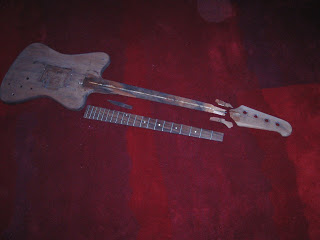
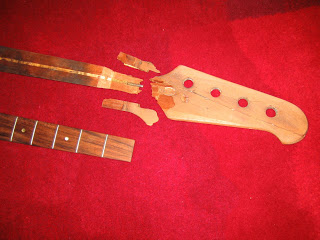
However, very little of the original wood was actually missing - and the pieces could be put together - kind of like a jigsaw puzzle. There is no glue holding the pieces together in the lower picture.
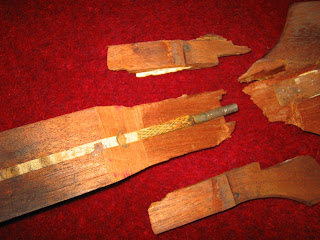
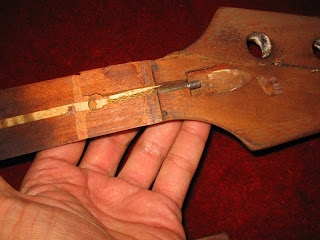
It was obvious that the headstock had been badly broken - and split - sometime in the past, and then doweled and glued together - but apparently the bass had suffered another fall that this time smashed the neck joint, though the headstock stayed together.
The body had also been routed or chiseled out for some kind of pickup modification - which was going to have to be filled with a mahogany block and re-routed.

David wanted the bass set up as a Thunderbird 2 - with a single pickup, which I could conveniently copy from one of my Thunderbird 2's.
Then came the ADDITIONAL challenge - David said that he'd really prefer to have the bass refinished in the typical tobacco burst finish that was stock on all 1960s Thunderbirds. The problem with that finish is that the majority of the bass is finished in a clear lacquer, with just the edges finished in a dark walnut for a simple two color burst. This finish would make the routing repair visible on the top, since not all of it would be hidden under a pickguard.
We agreed to therefore do a thin mahogany veneer over the top surface of the bass - once it was repaired/plugged - so that the finish would look correct. I had used a glue-backed veneer product from Rockler years ago to do some furniture repair - and I knew it was a durable solution - but still not something I'd done on a guitar before.
The headstock repair I suggested hiding by shading the back of the neck in a "burst" (like Guild did on many of their archtop instruments). The front of the headstock will be black, so that's not an issue.
The first step was to plug the body route - which I first cleaned up to an even depth and rectangular shape - gluing in a nice block of mahogany.
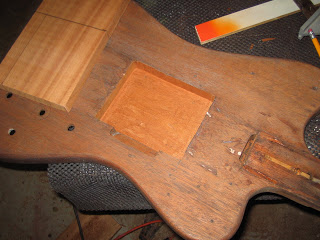
The remaining chips and small gaps were filled with cellulose wood filler. The extra control pot hole was also plugged. The entire top will be sanded down smooth and sealed before the veneering to ensure a solid attachment and smooth finish.

I decided that the approach I'd take to repair the headstock was to first piece back together what I had - thereby getting the correct headstock alignment and angle - and then basically laminate/splice several pieces of wood across the shattered area. This would require cutting away on one or more faces of the joint. Finally - I might add in a few small dowels at an angle to anchor the new spliced across the break - though I wasn't sure this would be necessary. The general approach is similar to the one I used to rebuild an EB-3 with a smashed headstock and several missing chunks of wood.
After discussion with John Mouradian of Mouradian Guitar, I decided to use the fairly nasty polyurethane glue made by Titebond - which promised a very strong joint and was also drillable. I have used urethane glues before - and they can sorta of make a mess as they foam up as they set - and stain wood too. But in this case, a few stains on the wood was the least of my worries.
I had to fit a shim in where some wood was missing - apparently someone started to saw on the neck as they contemplated attaching an entirely new headstock - and I first glued the two small pieces onto the rest of the neck - rather than trying to do everything at once.


Once the initial glueing was dried - I cleaned away any foamed urethane from the gluing surfaces - and fitted the headstock on. I glued and clamped this, being careful to have a very tight fit and correct alignment of the headstock to the neck.
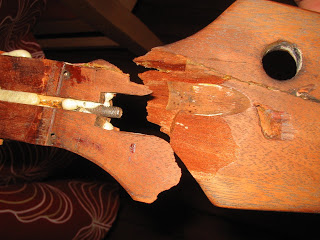
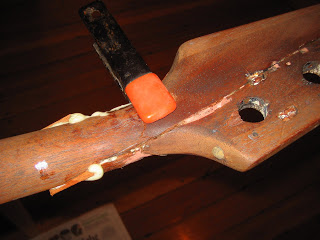
Once the glue was dry - you can see how the neck did fit together well again. Note how much the glue foamed up.


I cleaned up the glue and the wood and the splice I had put in place.
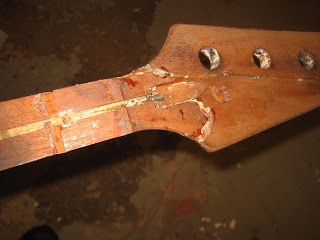
The cleanup revealed a few places where small chunks of wood were missing - which I glued in before I started the splicing operation. Once these are set in place, I'll carve/file them down to match the contours of the guitar.
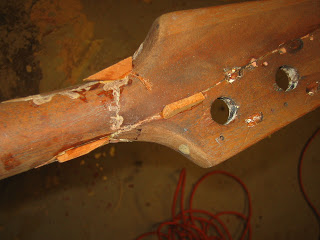
Next up - splicing and veneering !!
(Update January 9, 2009)
After a long break, I'm finally back to updating my blog - and there has been a bit of progress on the Thunderbird over the past month or so.
The biggest achievement is that the neck is finally all back together - with the headstock joint reinforced and the fretboard glued back on - and the front of the body has had a mahogany veneer applied. The bass has actually been strung up to make sure everything is solid too.
For the t-bird's body - cleaned up the sloppy routing/chiseling work that had been done with a router, and then inlaid a nice even block of mahogany. However, since the owner wanted an aged clear finish on the body, he requested that I apply a mahogany veneer to the front of the body. We figured if there was a visible glue seam at the edges, I could apply a tobacco burst finish to cover it up.
To apply the veneer, I rough cut the veneer to shape, and then carefully trimmed the piece to fit around the neck - aligning the grain of the veneer with the centerline of the body. I measured and then drilled small pilot holes for the bridge studs and one tailpiece stud.
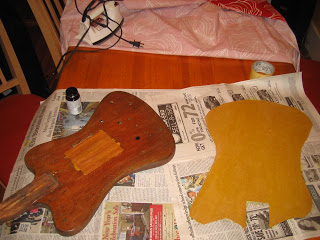
A solvent-based contact cement was applied to both the back of the veneer and the top of the T-bird - when this had dried for 30 minutes, the veneer was carefully pressed onto the guitar body, starting from the neck area and gradually working outwards from there. I used my hands and then a cold iron to press the veneer flush.
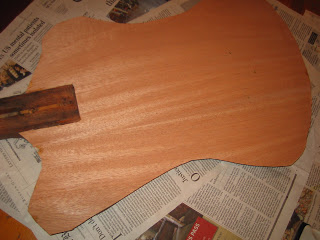
I then warmed up the iron - and using low heat - further worked the veneer to make sure there were no bubbles or loose spots. The veneer was then trimmed down carefully - the edges will be sanded later to get a nice smooth radius.
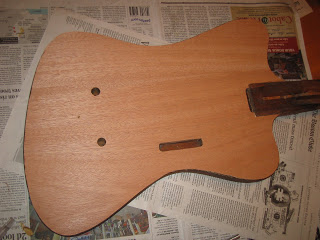
The other are of major work was the neck. When I last posted, I was still working on the headstock and had spliced in some small pieces of mahogany to fill some gaps here and there.
I cleaned out the truss rod channel - part of the maple inlay at fallen out - and I then further routed out the channel so that could glue in a longer piece of maple that would overlap the neck break.
The next step was to cut away part of the area where the fretboard would glue back on, near the nut, so that I could laminate in a thin sheet of wood that would also overlap both sides of the break - this will strengthen and stiffen this area, which is the thinnest part of the Thunderbird neck.
I set up a jig to hold the T-bird level so that I could use my small Dremel-style tool with a router attachment to cut away part of the neck. The picture below shows the rig right after the routing operation.
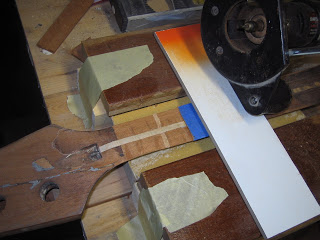
I then laminated on a 1/16th thick piece of mahogany.
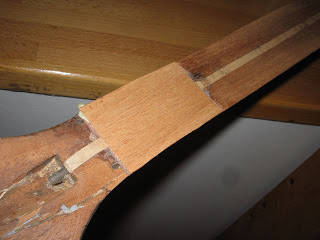
The laminated sheet and the maple truss rod channel inlay that go across the neck break will really help to make this a solid joint. I used Titebond Polyurethane glue for all the bonding in this area - as its about the strongest and toughest non-epoxy glue around.
The gluing surface was then cleaned up with a sanding block and the splice was sanded level with the rest of the face of the neck.
I also tried to clean up the back of the fretboard which had glue and some splinter attached - but it also had one LARGE chunk of mahogany adhered to it, which I decided to leave in place since it fit tightly into the corresponding gap in the neck and I figured it would ensure the fretboard was properly aligned (more on this later).
I used regular Titebond wood glue for the fretboard - spreading a thin even layer on the rosewood - and then clamped everything together - using a radiused clamping block in the damaged area I mentioned above.
The neck was clamped with a slight backset or backbow built in - approximately 1/16th of an inch at the nut (that is, if you put a straight edge against the fretboard aligned with the highest frets on the neck, there would be a gap of 1/16th inch at the nut due to the neck bending backwards). I did this because of the thinness of the T-bird neck and the limited "authority" of the T-bird truss rod in correcting neck relief due to string tension. I also had the adjustment nut completely removed from the truss-rod during this stage.
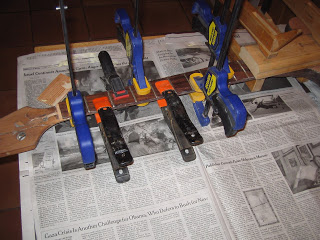
Once the glue had dried for 48 hours, it was time to test out not only the strength of my headstock repair, but also to see how flat the fretboard was under tension. I knew that I might very well have to have the neck heated and pressed if it twisted or had excessive relief - but I was confident that was an option, since I had just had Jon Mouradian do exactly that to my own Kerry Green 1966 Thunderbird.
I mounted the tailpiece (unusually far forward for an NR T-bird!) and the bridge - and put a set of 70s T-bird tuners on the headstock plus a set of old strings. I gradually tightened up the strings until they were at pitch and then let the 'bird sit overnight.

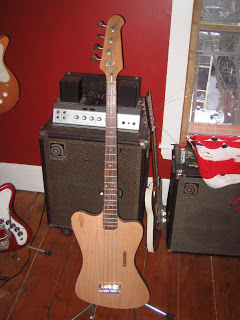
The good news was that everything was solid - no cracks or movement of the headstock - but the bad news was that that fretboard had a hump in the area where it had cracked and part of the neck had stayed attached to fretboard. The neck had actually pulled almost perfectly straight, with the exception of the fretboard hump, once it was under tension - remember - at this point I didn't have the truss-rod tightened at all. After a few days - I did apply a little tension to the rod - put there is plenty of truss rod action left over in case the neck does start to get some relief over time.
I decided that the best option was to defret the neck and then plane out the hump - this would also allow me to make sure the fretboard would be level everywhere else - and probably not a bad idea on a neck rebuild of this magnitude anyway!
Since I WAS happy with the neck relief overall - and simply wanted to remove the hump - I securely clamped the strung up bass to a workbench - then shimmed the neck at several points to maintain the same neck relief once the strings (and frets) were removed.
The picture below shows the bass clamped down, frets removed and the fretboard after leveling with 12-inch radius block from Stewart-Macdonald. I had considered re-installing the original frets, but they are fairly worn and a few took a beating during the removal process. The fretboard is a beautiful piece of rosewood however !
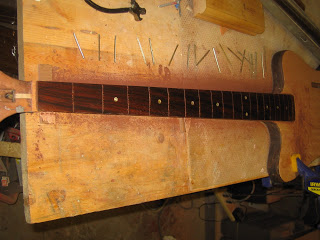
(Update March 1st, 2009)
Its been a while since I did a progress report on the T-bird - and its actually now very close to completion.
At the time of the last post, I had planed the fretboard to remove a hump left after I glued the fretboard back onto the neck. It was fairly easy to refret the board, using the original frets. I had to do a little cosmetic bending of a few of them and then a little filing of the ends and an edge here and there, but they looked good once they were re-installed.
After some thought - I decided that I wanted to reinforce the headstock repair further - first by putting a splice across the break on the back of the headstock/neck junction - and then a splice from the string nut to a bit past the truss rod adjustment routing. With all the work that had gone into the bass, I didn't want to risk the headstock coming loose over time or from being bumped into a wall somewhere.
That completed the structural repairs - now came the time for the refinish.
As the pictures show, the new veneered mahogany top was much lighter than the rest of the bass. As an initial step, I lightly stained the mahogany using a Minwax cherry stain, with some medium brown dye added to further darken it.
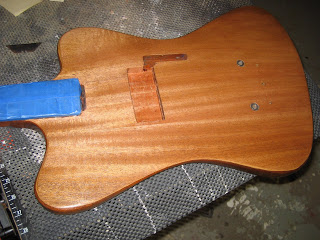
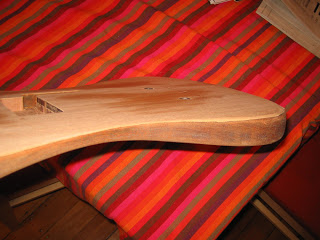
Then came the grain filler for the top - which was applied liberally using a rag - with the excess then scraped off with thin plastic shim (actually an expired credit card!). Once the filler dried, the entire surface was sanded such the the filler was left only in the pores of the mahogany's grain. I used a dark brown, walnut colored oil-based filler.
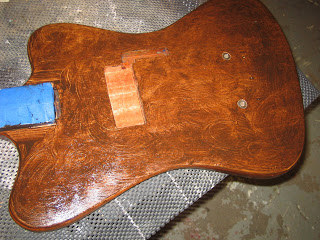
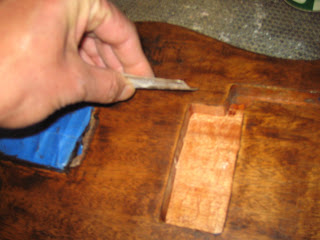
Once the grain was filled the bass was ready for the initial coats of lacquer. To try to get the front of the body closer to the rest of the bass, I used a clear coat tinted with equal parts vintage amber and medium brown dye, with a little bit of cherry red added. For the rest of the body, I used a clear coat tinted with vintage amber and medium brown dye to a lesser degree, since I didn't want to darken the wood too much, but I did want to add a little warmth to the color.
The end result matched the front to the back quite well - once the tobacco burst was applied it would be difficult to tell that the front was a veneered surface.

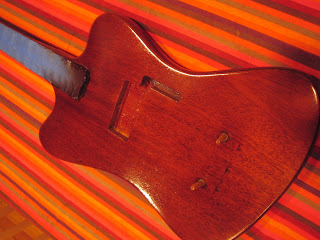
I went a little heavier with the tint on the heavily repaired headstock, though I planned on eventually shading the back of the headstock in walnut to hide the repair as much as possible. In this view you can see the splice across the break on the back of the neck.
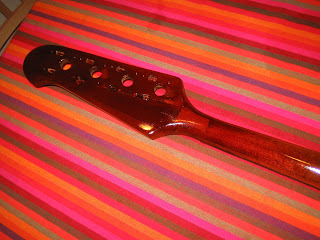
After a clear coat to seal in the bass color, the time came to apply the tobacco burst finish to the front of the body and to shade the headstock repair.
I used my smaller HVLP spray gun, since I wanted to have good control over the edging and to get a soft edge between the darker edge and the underlying color. I used a mix of 50% walnut and 50% medium brown dye in clear lacquer base, tinted quite heavily. For comparison, when I do a Fender 3-color burst, I use a straight walnut dye tinted clear, which results in a nearly black color. For the T-bird, I wanted an opaque color but with a definite brown tone as opposed to looking like a black edging.
The picture below is the tobacco burst applied and sealed in with a lightly ambered clear coat, with some of the hardware in place to give an idea of the final appearance.

This picture shows the heavy shading used to cover up the headstock rebuild.
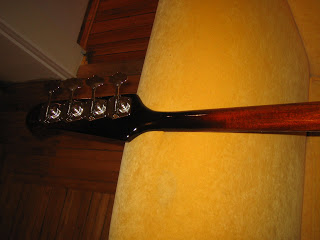
The bass was given several more clear coats of nitro after this, and then the finish was allowed to cure for roughly a week before the entire bass was wet sanded, from 400 grit down to 2000 grit, followed by two grades of buffing compound and final rubout with swirl remover.
While the finish was curing, I also finished fabricating some parts, such as the rear control cover, the truss rod cover and the a brass shield for the control cavity. Tomorrow, I will do the final assembly and then post a number of pictures of the completed instrument.
- 1967 Fender Jazz Bass: Rebuilding A Water-damaged Rosewood Veneer Fretboard
I took this project on more as a challenge than as a typical repair - not sure how much I'd charge to do it again, but almost certainly A LOT more than I did in this case I'm documenting ! That being said - this repair does show the resiliency...
- 1963 Fiesta Red Fender Precision Refinish Ala Bruce Thomas
Another fine vintage Fender bass has come my way - and the owner, inspired by my Fiesta Red refin of a 1964 P-bass, asked if I could do the same for his 1963, clay dot example, which had been refinished some years ago in a light metallic teal color,...
- 1971 Gibson Eb-3 - Basketcase Redemption
I finished this project roughly 5 years ago - but I think its an interesting one as it demonstrates a pretty extreme headstock repair and also inlaying wood into a top to repair "artistic" carving. The subject was a 1971 Gibson EB-3 bass,...
- G&l L1000 Bass - Partial Refinish
Another project that has recently come my way - an early 80s G&L L-1000 bass with a mahogany body and a transparent brown or mocha finish - that has suffered from some sort of finish deterioration on the front face only. The pits in the finish actually...
- One Way To Repair A Fender Trussrod - 63 Jazz Bass Neck
I did this repair as part of a complex deal to get a slab-board Fender Precision P-bass/Jazz bass neck with a C.A.R. headstock. Anyone have a spare C.A.R. P-bass body hanging around ? :) So anyway - the truss rod on this bass apparently broken at the...
Guitar
Updated! 1966 Gibson Thunderbird: Gluing back together the bits and pieces!!
<
This is one of the most ambitious rebuild projects I have undertaken yet - perhaps THE most ambitious - and it remains to be seen how it works out in the end. This is a project for a client - my friend David from New York, who owns the Guild Starfire Bass I refinished in natural mahogany last year. I guess he wanted to challenge me with this project !!
Plus he knows that I'm a big fan of the non-reverse Thunderbirds and Firebirds and I've rebuilt a few of each over the years.
David acquired this poor poor 'bird from our fellow bass freak Joe out in the Chicago area - Joe had acquired it from parts unknown some time ago, but gave up on having it rebuilt and passed the project onto David - who actually simply had Joe send it to me.
As you can see - the neck of the bass was in several pieces - and the fretboard had been somewhat roughly removed - which dislodged an additional piece of wood lower on the neck.
However, very little of the original wood was actually missing - and the pieces could be put together - kind of like a jigsaw puzzle. There is no glue holding the pieces together in the lower picture.
It was obvious that the headstock had been badly broken - and split - sometime in the past, and then doweled and glued together - but apparently the bass had suffered another fall that this time smashed the neck joint, though the headstock stayed together.
The body had also been routed or chiseled out for some kind of pickup modification - which was going to have to be filled with a mahogany block and re-routed.
David wanted the bass set up as a Thunderbird 2 - with a single pickup, which I could conveniently copy from one of my Thunderbird 2's.
Then came the ADDITIONAL challenge - David said that he'd really prefer to have the bass refinished in the typical tobacco burst finish that was stock on all 1960s Thunderbirds. The problem with that finish is that the majority of the bass is finished in a clear lacquer, with just the edges finished in a dark walnut for a simple two color burst. This finish would make the routing repair visible on the top, since not all of it would be hidden under a pickguard.
We agreed to therefore do a thin mahogany veneer over the top surface of the bass - once it was repaired/plugged - so that the finish would look correct. I had used a glue-backed veneer product from Rockler years ago to do some furniture repair - and I knew it was a durable solution - but still not something I'd done on a guitar before.
The headstock repair I suggested hiding by shading the back of the neck in a "burst" (like Guild did on many of their archtop instruments). The front of the headstock will be black, so that's not an issue.
The first step was to plug the body route - which I first cleaned up to an even depth and rectangular shape - gluing in a nice block of mahogany.
The remaining chips and small gaps were filled with cellulose wood filler. The extra control pot hole was also plugged. The entire top will be sanded down smooth and sealed before the veneering to ensure a solid attachment and smooth finish.
I decided that the approach I'd take to repair the headstock was to first piece back together what I had - thereby getting the correct headstock alignment and angle - and then basically laminate/splice several pieces of wood across the shattered area. This would require cutting away on one or more faces of the joint. Finally - I might add in a few small dowels at an angle to anchor the new spliced across the break - though I wasn't sure this would be necessary. The general approach is similar to the one I used to rebuild an EB-3 with a smashed headstock and several missing chunks of wood.
After discussion with John Mouradian of Mouradian Guitar, I decided to use the fairly nasty polyurethane glue made by Titebond - which promised a very strong joint and was also drillable. I have used urethane glues before - and they can sorta of make a mess as they foam up as they set - and stain wood too. But in this case, a few stains on the wood was the least of my worries.
I had to fit a shim in where some wood was missing - apparently someone started to saw on the neck as they contemplated attaching an entirely new headstock - and I first glued the two small pieces onto the rest of the neck - rather than trying to do everything at once.
Once the initial glueing was dried - I cleaned away any foamed urethane from the gluing surfaces - and fitted the headstock on. I glued and clamped this, being careful to have a very tight fit and correct alignment of the headstock to the neck.
Once the glue was dry - you can see how the neck did fit together well again. Note how much the glue foamed up.
I cleaned up the glue and the wood and the splice I had put in place.
The cleanup revealed a few places where small chunks of wood were missing - which I glued in before I started the splicing operation. Once these are set in place, I'll carve/file them down to match the contours of the guitar.
Next up - splicing and veneering !!
(Update January 9, 2009)
After a long break, I'm finally back to updating my blog - and there has been a bit of progress on the Thunderbird over the past month or so.
The biggest achievement is that the neck is finally all back together - with the headstock joint reinforced and the fretboard glued back on - and the front of the body has had a mahogany veneer applied. The bass has actually been strung up to make sure everything is solid too.
For the t-bird's body - cleaned up the sloppy routing/chiseling work that had been done with a router, and then inlaid a nice even block of mahogany. However, since the owner wanted an aged clear finish on the body, he requested that I apply a mahogany veneer to the front of the body. We figured if there was a visible glue seam at the edges, I could apply a tobacco burst finish to cover it up.
To apply the veneer, I rough cut the veneer to shape, and then carefully trimmed the piece to fit around the neck - aligning the grain of the veneer with the centerline of the body. I measured and then drilled small pilot holes for the bridge studs and one tailpiece stud.
A solvent-based contact cement was applied to both the back of the veneer and the top of the T-bird - when this had dried for 30 minutes, the veneer was carefully pressed onto the guitar body, starting from the neck area and gradually working outwards from there. I used my hands and then a cold iron to press the veneer flush.
I then warmed up the iron - and using low heat - further worked the veneer to make sure there were no bubbles or loose spots. The veneer was then trimmed down carefully - the edges will be sanded later to get a nice smooth radius.
The other are of major work was the neck. When I last posted, I was still working on the headstock and had spliced in some small pieces of mahogany to fill some gaps here and there.
I cleaned out the truss rod channel - part of the maple inlay at fallen out - and I then further routed out the channel so that could glue in a longer piece of maple that would overlap the neck break.
The next step was to cut away part of the area where the fretboard would glue back on, near the nut, so that I could laminate in a thin sheet of wood that would also overlap both sides of the break - this will strengthen and stiffen this area, which is the thinnest part of the Thunderbird neck.
I set up a jig to hold the T-bird level so that I could use my small Dremel-style tool with a router attachment to cut away part of the neck. The picture below shows the rig right after the routing operation.
I then laminated on a 1/16th thick piece of mahogany.
The laminated sheet and the maple truss rod channel inlay that go across the neck break will really help to make this a solid joint. I used Titebond Polyurethane glue for all the bonding in this area - as its about the strongest and toughest non-epoxy glue around.
The gluing surface was then cleaned up with a sanding block and the splice was sanded level with the rest of the face of the neck.
I also tried to clean up the back of the fretboard which had glue and some splinter attached - but it also had one LARGE chunk of mahogany adhered to it, which I decided to leave in place since it fit tightly into the corresponding gap in the neck and I figured it would ensure the fretboard was properly aligned (more on this later).
I used regular Titebond wood glue for the fretboard - spreading a thin even layer on the rosewood - and then clamped everything together - using a radiused clamping block in the damaged area I mentioned above.
The neck was clamped with a slight backset or backbow built in - approximately 1/16th of an inch at the nut (that is, if you put a straight edge against the fretboard aligned with the highest frets on the neck, there would be a gap of 1/16th inch at the nut due to the neck bending backwards). I did this because of the thinness of the T-bird neck and the limited "authority" of the T-bird truss rod in correcting neck relief due to string tension. I also had the adjustment nut completely removed from the truss-rod during this stage.
Once the glue had dried for 48 hours, it was time to test out not only the strength of my headstock repair, but also to see how flat the fretboard was under tension. I knew that I might very well have to have the neck heated and pressed if it twisted or had excessive relief - but I was confident that was an option, since I had just had Jon Mouradian do exactly that to my own Kerry Green 1966 Thunderbird.
I mounted the tailpiece (unusually far forward for an NR T-bird!) and the bridge - and put a set of 70s T-bird tuners on the headstock plus a set of old strings. I gradually tightened up the strings until they were at pitch and then let the 'bird sit overnight.
The good news was that everything was solid - no cracks or movement of the headstock - but the bad news was that that fretboard had a hump in the area where it had cracked and part of the neck had stayed attached to fretboard. The neck had actually pulled almost perfectly straight, with the exception of the fretboard hump, once it was under tension - remember - at this point I didn't have the truss-rod tightened at all. After a few days - I did apply a little tension to the rod - put there is plenty of truss rod action left over in case the neck does start to get some relief over time.
I decided that the best option was to defret the neck and then plane out the hump - this would also allow me to make sure the fretboard would be level everywhere else - and probably not a bad idea on a neck rebuild of this magnitude anyway!
Since I WAS happy with the neck relief overall - and simply wanted to remove the hump - I securely clamped the strung up bass to a workbench - then shimmed the neck at several points to maintain the same neck relief once the strings (and frets) were removed.
The picture below shows the bass clamped down, frets removed and the fretboard after leveling with 12-inch radius block from Stewart-Macdonald. I had considered re-installing the original frets, but they are fairly worn and a few took a beating during the removal process. The fretboard is a beautiful piece of rosewood however !
(Update March 1st, 2009)
Its been a while since I did a progress report on the T-bird - and its actually now very close to completion.
At the time of the last post, I had planed the fretboard to remove a hump left after I glued the fretboard back onto the neck. It was fairly easy to refret the board, using the original frets. I had to do a little cosmetic bending of a few of them and then a little filing of the ends and an edge here and there, but they looked good once they were re-installed.
After some thought - I decided that I wanted to reinforce the headstock repair further - first by putting a splice across the break on the back of the headstock/neck junction - and then a splice from the string nut to a bit past the truss rod adjustment routing. With all the work that had gone into the bass, I didn't want to risk the headstock coming loose over time or from being bumped into a wall somewhere.
That completed the structural repairs - now came the time for the refinish.
As the pictures show, the new veneered mahogany top was much lighter than the rest of the bass. As an initial step, I lightly stained the mahogany using a Minwax cherry stain, with some medium brown dye added to further darken it.
Then came the grain filler for the top - which was applied liberally using a rag - with the excess then scraped off with thin plastic shim (actually an expired credit card!). Once the filler dried, the entire surface was sanded such the the filler was left only in the pores of the mahogany's grain. I used a dark brown, walnut colored oil-based filler.
Once the grain was filled the bass was ready for the initial coats of lacquer. To try to get the front of the body closer to the rest of the bass, I used a clear coat tinted with equal parts vintage amber and medium brown dye, with a little bit of cherry red added. For the rest of the body, I used a clear coat tinted with vintage amber and medium brown dye to a lesser degree, since I didn't want to darken the wood too much, but I did want to add a little warmth to the color.
The end result matched the front to the back quite well - once the tobacco burst was applied it would be difficult to tell that the front was a veneered surface.
I went a little heavier with the tint on the heavily repaired headstock, though I planned on eventually shading the back of the headstock in walnut to hide the repair as much as possible. In this view you can see the splice across the break on the back of the neck.
After a clear coat to seal in the bass color, the time came to apply the tobacco burst finish to the front of the body and to shade the headstock repair.
I used my smaller HVLP spray gun, since I wanted to have good control over the edging and to get a soft edge between the darker edge and the underlying color. I used a mix of 50% walnut and 50% medium brown dye in clear lacquer base, tinted quite heavily. For comparison, when I do a Fender 3-color burst, I use a straight walnut dye tinted clear, which results in a nearly black color. For the T-bird, I wanted an opaque color but with a definite brown tone as opposed to looking like a black edging.
The picture below is the tobacco burst applied and sealed in with a lightly ambered clear coat, with some of the hardware in place to give an idea of the final appearance.
This picture shows the heavy shading used to cover up the headstock rebuild.
The bass was given several more clear coats of nitro after this, and then the finish was allowed to cure for roughly a week before the entire bass was wet sanded, from 400 grit down to 2000 grit, followed by two grades of buffing compound and final rubout with swirl remover.
While the finish was curing, I also finished fabricating some parts, such as the rear control cover, the truss rod cover and the a brass shield for the control cavity. Tomorrow, I will do the final assembly and then post a number of pictures of the completed instrument.
- 1967 Fender Jazz Bass: Rebuilding A Water-damaged Rosewood Veneer Fretboard
I took this project on more as a challenge than as a typical repair - not sure how much I'd charge to do it again, but almost certainly A LOT more than I did in this case I'm documenting ! That being said - this repair does show the resiliency...
- 1963 Fiesta Red Fender Precision Refinish Ala Bruce Thomas
Another fine vintage Fender bass has come my way - and the owner, inspired by my Fiesta Red refin of a 1964 P-bass, asked if I could do the same for his 1963, clay dot example, which had been refinished some years ago in a light metallic teal color,...
- 1971 Gibson Eb-3 - Basketcase Redemption
I finished this project roughly 5 years ago - but I think its an interesting one as it demonstrates a pretty extreme headstock repair and also inlaying wood into a top to repair "artistic" carving. The subject was a 1971 Gibson EB-3 bass,...
- G&l L1000 Bass - Partial Refinish
Another project that has recently come my way - an early 80s G&L L-1000 bass with a mahogany body and a transparent brown or mocha finish - that has suffered from some sort of finish deterioration on the front face only. The pits in the finish actually...
- One Way To Repair A Fender Trussrod - 63 Jazz Bass Neck
I did this repair as part of a complex deal to get a slab-board Fender Precision P-bass/Jazz bass neck with a C.A.R. headstock. Anyone have a spare C.A.R. P-bass body hanging around ? :) So anyway - the truss rod on this bass apparently broken at the...
